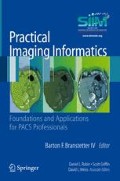Abstract
Medical imaging technologies enable views of the internal structure and function of the human body. Information obtained from the various modalities can be used to diagnose abnormalities, guide therapeutic procedures, and monitor disease treatment.
Access this chapter
Tax calculation will be finalised at checkout
Purchases are for personal use only
Suggested Reading
Brown BH, Smallwood RH, Barber DC, Lawford PV, Hose DR. Medical Physics and Biomedical Engineering. London: Institute of Physics Publishing; 1999.
Gonzalez RC, Woods RE. Digital Image Processing. Reading, MA: Addison-Wesley Publishing Co.; 1993.
Rosenfeld A, Kak AC. Digital Picture Processing. San Diego, CA: Academic Press, Inc.; 1982.
Webb A. Introduction to Biomedical Imaging. Hoboken, NJ: John Wiley & Sons, Inc.; 2003.
Author information
Authors and Affiliations
Editor information
Editors and Affiliations
Self-Assessment Questions
Self-Assessment Questions
-
1.
Which of the following is the most significant source of artifact in medical images?
-
a.
Human variability
-
b.
Patient positioning
-
c.
X-ray dose
-
d.
Subject motion
-
e.
Safety considerations
-
a.
-
2.
Which of the following imaging modalities use ionizing radiation as its source?
-
a.
Magnetic Resonance Imaging
-
b.
Computed Tomography
-
c.
Ultrasound imaging
-
d.
All of the above
-
E.
None of the above
-
a.
-
3.
Which of the following modality is most affected by the skill of the operator?
-
a.
Projection radiography
-
b.
Ultrasound
-
c.
Computed Tomography
-
d.
Magnetic Resonance Imaging
-
e.
Positron Emission Tomography
-
a.
-
4.
In the formation of a digital image, sampling affects which of the following?
-
a.
Visible fine detail
-
b.
Image matrix size
-
c.
Spatial resolution
-
d.
All of the above
-
e.
None of the above
-
a.
-
5.
Which imaging modality provides higher spatial resolution?
-
a.
Chest radiograph
-
b.
Chest CT
-
a.
Rights and permissions
Copyright information
© 2009 Society for Imaging Informatics in Medicine
About this chapter
Cite this chapter
Andriole, K.P. (2009). Medical Imaging Modalities and Digital Images. In: Branstetter, B. (eds) Practical Imaging Informatics. Springer, New York, NY. https://doi.org/10.1007/978-1-4419-0485-0_1
Download citation
DOI: https://doi.org/10.1007/978-1-4419-0485-0_1
Published:
Publisher Name: Springer, New York, NY
Print ISBN: 978-1-4419-0483-6
Online ISBN: 978-1-4419-0485-0
eBook Packages: MedicineMedicine (R0)

